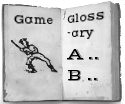Ball-Paces: Difference between revisions
Jump to navigation
Jump to search
(Categorize Tags into Eras and Regions) |
(Change Game Eras from 1800s to 1800s,Predecessor) |
||
| Line 4: | Line 4: | ||
|Location=Scotland | |Location=Scotland | ||
|Game Regions=Britain | |Game Regions=Britain | ||
|Game Eras=1800s | |Game Eras=1800s,Predecessor | ||
|Description=<p>per Block. The 1836 book Perth Traditions described Ball-Paces, by then almost extinct, as a game that used a trap to put a ball into play, at which point in-team runners at each of four bases run to the next bases, stopping only when the ball was returned to the original batsman’s station. There is no mention of plugging.</p> | |Description=<p>per Block. The 1836 book Perth Traditions described Ball-Paces, by then almost extinct, as a game that used a trap to put a ball into play, at which point in-team runners at each of four bases run to the next bases, stopping only when the ball was returned to the original batsman’s station. There is no mention of plugging.</p> | ||
|Sources=<p><span>David Block, email of 5/17/2005.</span></p> | |Sources=<p><span>David Block, email of 5/17/2005.</span></p> | ||
}} | }} | ||
Latest revision as of 08:13, 28 November 2012
| Game | Ball-Paces |
|---|---|
| Game Family | Baseball |
| Location | Scotland |
| Regions | Britain |
| Eras | 1800s, Predecessor |
| Invented | |
| Tags | |
| Description | per Block. The 1836 book Perth Traditions described Ball-Paces, by then almost extinct, as a game that used a trap to put a ball into play, at which point in-team runners at each of four bases run to the next bases, stopping only when the ball was returned to the original batsman’s station. There is no mention of plugging. |
| Sources | David Block, email of 5/17/2005. |
| Source Image | [[Image:|left|thumb]] |
| Comment | Edit with form to add a comment |
| Query | Edit with form to add a query |
| Has Supplemental Text |
Comments
<comments voting="Plus" />
